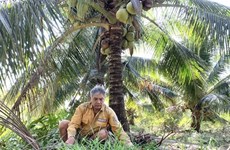Price of export Vietnamese bananas soar following increased demand
The Vietnamese banana industry has seen a relatively sharp increase in export prices since early this year due to surging demand on international markets.
 A Japanese customer is buying bananas in the Central Highlands Lam Dong province. (Photo: baolamdong.vn)
A Japanese customer is buying bananas in the Central Highlands Lam Dong province. (Photo: baolamdong.vn)Hanoi (VNA) - The Vietnamese banana industry has seen a relatively sharp increase in export prices since early this year due to surging demand on international markets.
Tran Danh The, Director of Dong Nai-based Tran The Biology Company, which specialises in biological research and the production of bananas, said there has been a price hike in exported bananas.
"Last year, one kilogramme of bananas for export sold at about 5,000-6,000 VND (22-26 US cents), but since early this year the prices have increased to 12,000-14,000 VND per kilogramme, more than double last year's price," The told the Vietnam News.
Not only has the price risen, but orders have also increased.
The said that he has recently received numerous orders from local banana exporters, especially from those companies exporting bananas to the Middle East, Russia and Japan.
"In only the first two months of this year, these companies have exported about 400 tonnes of bananas to foreign markets," The said.
"Importers are quite satisfied with Vietnamese bananas as the quality of local bananas has improved," he said.
But Vietnam's banana industry is facing stiff competition from the Philippines, the dominant supplier of fresh bananas to Japan, the Republic of Korea, China and New Zealand.
The said the export price for Philippine bananas range from 17,000 VND to 18,000 VND per kilogramme, higher than Vietnamese bananas, however their fruit is much better quality. The care taken in the Philippines to transportation and preservation helps keep the bananas appearing unscratched and beautiful.
The hike in banana prices in the south is also reflected in the northern regions.
Nguyen Thi Nga, Director of Hong Lan company, one of the leading fruit exporters in the northern Lao Cai Province, said the price of exported bananas has risen sharply since the beginning of the year, and that a kilogramme of bananas is currently selling for 12,000 VND, much higher than last year.
However, Nga said, despite the higher price of exported bananas, her company is still facing a severe shortage of bananas to export.
"Last winter, extreme weather posed many obstacles to cultivation. The record-low cold spell that raged across the northern region over the last few months has badly damaged my cultivation zones and crops," Nga said.
"Most of our fruit crops were ruined in the cold snap. Frost and sleet wiped out almost all our agricultural produce. Bananas are in short supply for local needs, let alone for export demands," Nga said.
Nga said she has received a large number of orders for bananas from foreign partners such as India, the United Arab Emirates, Kuwait, China and Japan, but as a result of the current crop failure her company could not adequately satisfy demand.
In addition, due to low banana prices last year, many farmers reduced their plantation area, exacerbating low supplies this year.
"Currently, China needs around 20-30 tonnes per day, and Japan asks for 15-20 tonnes, but my company cannot fully meet their needs", The said.
Nga's company owns 700 hectares of banana plantation, producing about 150,000 to 200,000 tonnes of bananas in 2014, exporting 12,000 to 15,000 tonnes of bananas to the international market in the same year.
However, in 2015, she said, the harsh weather conditions have cut banana output drastically to half the previous year, leading to a decline in export volume, which was estimated to reach only around 6,000 tonnes of bananas.
According to a representative of the Department of Processing and Trade for Agro-Forestry-Fisheries Products and Salt Production, Vietnam is a tropical country and also home to many precious banana plants. Banana plants are cultivated over large areas with high yield. Areas under banana cultivation account for 19 percent of Vietnam's total fruit plant area, with an annual output of about 1.4 million tonnes.
"China remains the largest banana importer for our country. Other foreign markets of Singapore, the Republic of Korea, Japan and many Eastern European countries also have increasing demand for bananas imported from Vietnam, but we do not have sufficient bananas to supply them," he said.
Explaining the low supply, the representative said Vietnam's banana plantations are not always planned in the best areas. Vietnam's preservation technologies have yet to meet international requirements, so it is often impossible to keep the fruit looking good. Thus, only a relatively few Vietnamese products have been licensed to penetrate high-end markets, including the Japanese market.
In a bid to improve the status quo, the Ministry of Agriculture and Rural Development has identified five key plantation areas for growing export bananas, including the Northern Midland and Mountainous region, the Red River Delta, the Central Coastal region, the Southeastern region and the Mekong Delta, he said.
To fully meet international standards, banana growers have to be careful and selective when choosing banana varieties, deciding which ones are suitable for the production conditions of each key cultivation area, he said.
"In the long term, studies and research on banana cultivation have to focus on generating banana varieties that are high-yield, high quality, are of better appearance and are also resistant to several dangerous diseases," he said.
Banana growers and exporters need to apply scientific knowledge and advanced technologies in the planting, harvesting, storage and preservation of bananas to improve fruit quality and productivity.
To help the bananas industry gain a firmer foothold in the global market, Vietnam should formulate appropriate policies and measures to meet regional and international criteria, which will enable more Vietnamese bananas to reach world markets, he said.-VNA













